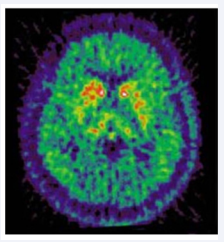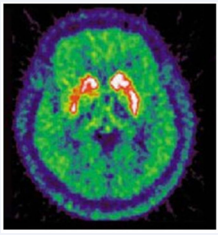Balancing the Apoptotic Switch
- 1. Medical Faculty, University of Ljubljana, Slovenia
- 2. Interdisciplinary research group TAVI, Slovenia
Abstract
Parkinson’s disease is a progressive neurological brain disorder characterized by tremors and difficulty in walking, movements and coordination. The disorder is most frequently diagnosed in persons who are in their mid 60’s and is more common in men than in women. Analyses of brain tissue from patients with Parkinson’s disease implicate apoptosis-related DNA damage and gene activation in the death of dopamine neurons. A questions remains whether there exists an apoptotic switch, which can balance the cells to become either cancerous or to die and consequently governs the dopamine storage capacity in brain? However new findings show the importance of several plants and especially vegetarian diet on the progress of cancer and neurodegeneration such as Parkinson’s disease as it was shown in our case of 64-year-old male patient. The patient managed to stabilize his state of Parkinson’s disease by vegetarin diet and food supplements including chlorella, royal jelly, Siberian ginseng, cranberries, aloe vera and many more. The susceptibility to neurodegeneration was lower, what lead to higher capacity of brain to store dopamine. His quality of life has improved and he is able to control disease. He is again able to walk for long periods, perform normal work in the garden, walk on treadmil with inclination (up hill). Cognitive functions remained stable and can more easily express himself in words. It was shown also by other research groups that vegetables and fruits involve a number of molecules, which can bring apoptotic switch to balance and therefore increase dopamine storage in the cells, when used in adequate quantities.
Keywords
• Parkinon’s disease
• Cancer
• Apoptosis
• Natural molecules from plants
Citation
Schwarzlin R, Salam S, Pušenjak N (2017) Balancing the Apoptotic Switch – From Cancer to Parkinson’s Disease. J Drug Des Res 4(1): 1030.
INTRODUCTION
Parkinson’s disease is a progressive neurological brain disorder characterized by tremors and difficulty in walking, movements and coordination. It is diagnosed by behavioral observation and clinical reports. The disorder is most frequently diagnosed in persons who are in their mid 60’s and is more common in men than in women. Evidence suggests that the neurons in the brain which produce dopamine play a crucial role in regulating movement and cognition. The degeneration and death of these dopaminergic cells produce the symptoms of Parkinson’s disease. As the dopaminergic cells die, control over movement is diminished and Parkinson’s disease symptoms are observable [1]. Although the cause of Parkinson’s disease is unknown, increased oxidative stress and mitochondrial dysfunction in dopamine neurons are central to the disease. Analyses of brain tissue from patients with Parkinson’s disease implicate apoptosis-related DNA damage and gene activation in the death of dopamine neurons [2]. A questions remains whether there exists an apoptotic switch, which can balance the cells to become either cancerous or to die? Can apoptotic switch balance the capacity of dopamine storage in the cells? Is there possible to influence this apoptotic switch with the same molecules(s) in order to bring the cells into balance, so there is no cancer and no neurodegeneration? As has been shown there are certain unique molecule complexes in the plants and other natural based products, which can regulate the apoptotic switch and influence dopamine storage [3,4]. We decided to test the same molecules in a patient with Parkinson’s disease. The following case report presents some new insight into the study of naturally based unique molecule complexes to restore the balance in the cells, enable sufficient dopamine stoarge and to protect them from entering cancerous or neurodegenerative process.
CASE REPORT
A 64-year-old male patient was accepted in the out-patient clinic due to food poisoning. He was experiencing strong dizziness, exhaustion, elevated body temperature and disentery with the traces of blood in the excretions. Blood sample tests revealed strongly elevated levels of CRP (46.3, normal is up to 10 mg/mL) and leukocytes (14.5, normal is up to 10, reference units 109 /L).
The general practice doctor prescribed amoksicilin clavulanic acid 625 mg daily (Amoksiklav 625 mg). Due to headaches, which had adverse effect on the symptoms of Parkinson’s disease, he later also took once tizanidine 2mg (Sirdalud 2mg). Blood sample tests after 14 days showed the CRP and leukocytes have returned to normal levels. After this episode of inflammation his health was never the same. A year after this event he experienced tremors in his right hand especially when writing or performing other accurate tasks. He was admitted to neurologic clinic and in 2009 Parkinson’s disease was confirmed through MRI, DAT scan, spirography, analysis for Cu in blood urin and blood analysis for ceruloplasmin. In the beginning he was prescribed once daily 125 mg bensenazide hydrochloride/levodopa (Madopar), next year 125 + 250 mg daily and pramipeksol (Mirapexin) starting from once daily 0.26 mg first week, second week 0.52 mg daily and the last week 1.05 mg once daily. As a patient had severe side effects of these medicines such as headaches, abdominal pain, fatique, neck pain, dry mouth, pain in the right section of chest, muscle spasms and constant need to urinate. Therefore the therapy with pramipeksol (Mirapexin) was slowly stopped. Six months after this episode the therapy was replaced by levodopa, cabidopa and entacapon (Stalevo) as follows: morning 100 mg, noon 125 mg, afternoon 125 mg and evening 250 mg. The patient complained that the symptoms of dyskinesia were stil present (half hour after the consumption of Stalevo). On his own initiaive the patient decided to study some literature on various food supplements suitable for Parkinson’s disease to ease the symptoms of Parkinson’s disease. Next year the specialist prescribed him five times daily 200 mg levodopa, cabidopa and entacapon (Stalevo). Due to renounced side effects decided on his own to take Stalevo only four times daily together with the following food supplements: 200 mg Chlorella (only one year), Royal Jelly 1000 mg, 1 dcl of Whey once daily, Siberian Ginseng 125 mg, Coenzyme Q10 30 mg, Cranberry 2000 mg, Aloe Vera 2000 mg, 42 mg of Magnesium Citrate. From the time of diagnosys the patient has been balancing diet and food supplements according to his condition. To this day the patient is able to walk for long periods, perform normal work in the garden, walk on treadmil with inclination (up hill). Cognitive functions remained stable and can more easily express himself in words. Tremors in his right hand are observed after physical work or sudden physiological or emotional stress. Quality of life has been improved. Currently he is maintaining vegetarian diet and is taking five times daily 150 mg of levodopa, cabidopa and entacapon (Stalevo 150 mg).
Figure 1: PET imaging of our patient in year 2011. Parkinson’s disease was confirmed in the symptomatic state. We can clearly see the loss of dopamine storage capacity in brain marked in the central region of the brain in red-yellow colour.
Figure 2: PET imaging of our patient in year 2016. Patient was regularly taking prescribed medicines. He changed his diet to vegetarian and was taking several nutritional supplements as described. Note that the state of Parkinson’s disease was improved and it is seen on the PET scan as pre-symptomatic. We see in the central part of the brain marked in white yellow colour new and increased storage of dopamine. Therefore the cognitive functions connected to the levels of dopamine, were improved.
DISCUSSION
As it was shown by several groups there is a connection from cancer to neurodegeneration [5-8] via apoptotic switch and loss of dopamine storage and other certain molecules such as ROS, p53, MYC, which are involved in cancer as well as in Parkinson’s disease progression [3,9-11]. However new findings show the importance of several plants and especially diet with a lot of vegetables and fruit on the progress of cancer and neurodegeneration such as Parkinson’s disease [1,12,13]. It was shown by Xiao J and his group that specific polysaccharides from wolfberry induces positive effects in nourishing the liver and neuron system [11], which was also in correlation with the observation of our patient. Another group showed that natural products containing garlic, green tea and milk thistle protected the nerves from ROS and consequently from neurodegeneration [4,15], decreasing the levels of CRP and in the same manner protected the liver cells to progress to a stage of cancer cells. Fort he past five years our patient was regularly consuming above mentioned natural products (cereals, almonds, nuts, pistacia, white garlic, pumpkin seeds, lentils) and other berries (dry raisins, cranberries). We discovered that five-year-rich food with natural food supplements and diet with a lot of green plants significantly stabilised his health, which was shown by dyskinesia and dizzines due to Stalevo as also shown by McCammon [1,12- 14,16,17]. New researches from recent years have shown the huge potential of many asiatic mushrooms. It was demonstrated that water soluble plant extract of Inonotus obliquus contains two crude polysaccharides IOW, IOA and mannitol, which work as effective scavengers for ROS and have clearly demonstrated antioxidative properties, with lowering CRP [9]. It was shown also by other research groups that vegetables and fruits involve a number of molecules, which can bring apoptotic switch to balance and clinically significant increase dopamine levels in the brain, when used in adequate quantities [1,12,13,16].
ACKNOWLEDGMENTS
We thank the patient for his consent to publish the case report and supplementary data. We gratefully acknowledge the contributions of Professor dr. Zvezdan Pirtošek from the Department of Neurology, University Medical Center Ljubljana for guiding and treatment of our patient.











































































































































